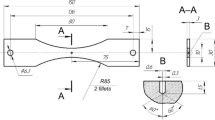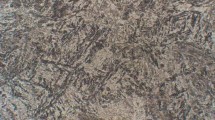Abstract
The effects of grain size and crack length on the threshold condition of fatigue growth of small cracks are analysed both theoretically and experimentally. The theoretical model is based on the assumption that the threshold condition is determined by whether the crack-tip slip band blocked by the grain boundary propagates into an adjacent grain or not. By comparing the model analysis with the experiments of mild steel, it was found that the threshold stress estimated from the fatigue limit of the smooth specimen gave the effective components of the applied stress. When the threshold stress normalized by the fatigue limit of the smooth specimen was correlated to the crack length normalized by a certain crack length, the theoretical relation was found to agree well with the experimental data. From a further analysis of the published data of various materials, the theoretical normalized relation was found to give a lower bound of the threshold values of the stress and the stress intensity factor. A deviation from the theoretical relation seen in the cases of hard metals was explained through an extension of the model by regarding that hard metals contained initial, inherent flaws even in the smooth specimen.
Résumé
On analyse d'une manière théorique et d'une manière expérimentale les effets de la taille du grain et de la longueur d'une fissure sur la condition critique de croissance par fatigue de petites fissures. Le modèle théorique est basé sur l'hypothèse que la condition critique est déterminée par la condition suivant laquelle une bande de glissement à l'extrémité de la fissure bloquée par une limite de grain se propage dans un grain adjacent ou non. En comparant le modèle analytique avec des essais sur de l'acier doux, on a trouvé que la contrainte critique estimée pour la limite de fatigue dans le cas d'éprouvettes sans entaille fournissait la composante effective de la contrainte appliquée. Lorsque la contrainte critique ramenée à la limite de fatigue d'éprouvettes sans entaille a été corrélée avec la longueur de fissure correspondante ramenée à une certaine longueur de fissure, la relation théorique a été trouvée en bon accord avec des données expérimentales. D'une analyse complémentaire des données publiées dans le cas de matériaux divers, on a trouvé que la relation théorique standard donnait une limite inférieure des valeurs critiques de la contrainte et du facteur d'intensité des contraintes. Une déviation par rapport à la relation théorique a été trouvée dans le cas de matériaux durs; cette déviation est expliquée par une extension du modèle, en considérant que des métaux durs comportent des défauts initiaux inhérent à la structure même dans le cas d'éprouvettes sans entaille.
Similar content being viewed by others
References
N.E.Frost, Proceedings of Institution of Mechanical Engineers, 173 (1959) 811–835.
N.E.Frost, Journal of Mechanical Engineering Science, 5 (1963) 15–22.
N.E.Frost, Journal of Mechanical Engineering Science, 6 (1964) 203–210.
H.Ohuchida, S.Usami, and A.Nishioka, Transactions of Japan Society of Mechanical Engineers, 41 (1975) 703–712.
S.Usami, and S.Shida, Fatigue of Engineering Materials and Structures, 1 (1979) 471–482.
H. Kitagawa, and S. Takahashi, Proceedings of 2nd International Conference on Mechanical Behavior of Materials, Boston (1976) 627–631.
H.Kitagawa, and S.Takahashi, Transactions of Japan Society of Mechanical Engineers, 45 (1979) 1289–1297.
Y. Nakai, and K. Tanaka, Proceedings of 23rd Japan Congress on Materials Research, (1980) 106–112.
J.Lankford, private communication (1979), International Journal of Fracture, 16 (1980) R7–9.
R.A.Smith, International Journal of Fracture, 13 (1977) RCR 717–720.
M.H. El Haddad, T.H.Topper and K.N.Smith, Engineering Fracture Mechanics, 11 (1979) 573–584.
S. Taira, and K. Tanaka, Proceedings of 3rd International Congress on Fracture, Munich, V-61 (1973).
B.A.Bilby, A.H.Cottrell and K.H.Swinden, Proceedings of Royal Society, (London) A272 (1963) 304–314.
S. Taira, K. Tanaka and M. Hoshina, American Society for Testing and Materials, STP 675 (1979) 135–162.
S.Taira, K.Tanaka and Y.Nakai, Mechanics Research Communications, 5 (1978) 375–381.
A.H.Cottrell, in Dislocations and plastic flow in crystals, Oxford University Press, Oxford (1953).
M. Kikukawa, M. Jono and K. Tanaka, Proceedings of 2nd International Conference on Mechanical Behavior of Materials, Boston, Special volume (1976) 254–277.
S.Taira, K.Tanaka and K.Watanabe, Transactions of Japan Society of Mechanicjal Engineers, 38 (1972) 3059–3066.
J.Lankford, Engineering Fracture Mechanics, 9 (1977) 617–624.
J. Gurland, American Society for Testing and Materials, STP 504 (1972) 108–118.
Author information
Authors and Affiliations
Rights and permissions
About this article
Cite this article
Tanaka, K., Nakai, Y. & Yamashita, M. Fatigue growth threshold of small cracks. Int J Fract 17, 519–533 (1981). https://doi.org/10.1007/BF00033345
Received:
Revised:
Issue Date:
DOI: https://doi.org/10.1007/BF00033345




